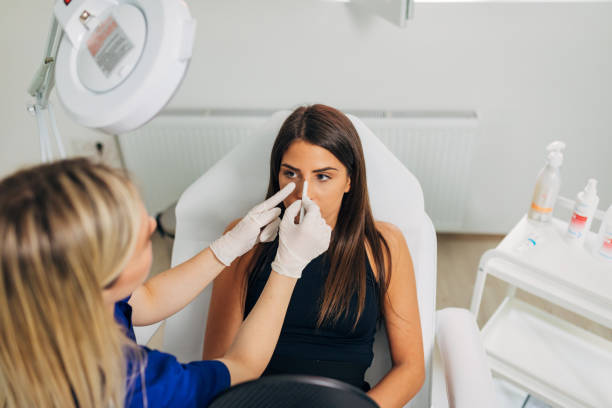The Future of Rhinoplasty in Riyadh: Robotics, AI, and Biomechanical Precision

Introduction: A New Era for Nasal Aesthetics in Riyadh
Rhinoplasty in Riyadh is entering a transformative phase, driven by the convergence of advanced robotics, artificial intelligence, and biomechanical engineering. Once viewed purely as a surgical art form based on the skill and intuition of the surgeon, rhinoplasty is now evolving into a high-tech discipline where precision is enhanced by intelligent systems. In a city where beauty standards are deeply intertwined with cultural identity and global exposure, patients are increasingly seeking results that are not only aesthetically refined but also biologically harmonious. The integration of cutting-edge technologies ensures that procedures can be performed with unmatched accuracy, minimized recovery times, and outcomes that are tailored to the unique anatomy and lifestyle of each patient.
Robotics in Rhinoplasty: Redefining Surgical Precision
Robotic systems are revolutionizing surgical practices in Riyadh by introducing an unprecedented level of steadiness and precision. In rhinoplasty, this translates to more accurate cartilage shaping, controlled bone modifications, and consistent tissue handling. Robotic-assisted instruments eliminate the micro-tremors inherent in human hands, ensuring each incision and contour adjustment is executed with millimeter accuracy. For Riyadh’s elite clientele, this precision minimizes the risk of irregularities and revision surgeries. Additionally, robotic platforms offer advanced visualization systems that magnify and illuminate the operative field, enabling surgeons to navigate intricate nasal structures without compromising surrounding tissues. These benefits align perfectly with the city’s growing demand for minimally invasive and low-trauma approaches to cosmetic surgery.
Artificial Intelligence in Pre-Surgical Planning
AI-powered simulation tools are fundamentally changing how surgeons in Riyadh prepare for Rhinoplasty in Riyadh. By analyzing high-resolution facial scans, AI can predict how specific surgical changes will affect not only the nose but also the harmony of the entire face. This capability allows surgeons to generate realistic, personalized previews for patients, fostering better communication and aligning expectations. AI can also analyze a vast database of past surgical outcomes, identifying subtle correlations between procedural choices and long-term results. In Riyadh, where cultural preferences often emphasize balance, softness, and natural contours, AI’s analytical power ensures that the surgical plan respects both the patient’s anatomy and their aesthetic aspirations.
Biomechanical Precision: Engineering Natural Movement
Biomechanics is bringing a deeper layer of science to rhinoplasty by focusing on how the nose functions and moves, not just how it looks. In Riyadh’s advanced surgical centers, biomechanical modeling is used to predict how cartilage, skin, and bone will respond to alterations over time. This ensures that structural changes enhance both nasal airflow and durability, preventing collapse or asymmetry years after surgery. For example, computer models can simulate the impact of graft placement on breathing efficiency and structural resilience, enabling surgeons to make adjustments before entering the operating room. This forward-thinking approach guarantees results that not only meet immediate cosmetic goals but also age gracefully with the patient.
Cultural Sensitivity Meets Technological Mastery
One of Riyadh’s defining challenges in rhinoplasty is achieving a balance between global beauty standards and the cultural nuances of local aesthetics. AI and robotic systems are being trained to incorporate regional preferences, such as preserving certain nasal features that are culturally significant while refining proportions to meet the patient’s vision. For instance, while some patients may request dorsal hump reduction, others may prefer subtle reshaping that retains a distinctive profile. This fusion of cultural sensitivity and technological precision ensures that outcomes resonate deeply with personal identity, avoiding the “overdone” look that many patients wish to avoid.
Minimally Invasive Robotics for Faster Recovery
Advanced robotic tools in Riyadh’s surgical theaters are enabling rhinoplasty to become less invasive than ever before. Micro-endoscopic assistance allows surgeons to operate through smaller incisions, reducing trauma to surrounding tissues. The result is shorter recovery times, minimal swelling, and a faster return to professional and social life—an important factor for Riyadh’s high-profile patients. Combined with AI-guided planning, these minimally invasive techniques also reduce post-operative unpredictability, ensuring that the final result closely matches the pre-surgical simulation. This approach represents a significant leap forward in patient comfort and satisfaction.
AI-Driven Post-Surgical Monitoring and Healing Optimization
The role of AI in rhinoplasty does not end in the operating room. In Riyadh, advanced post-operative monitoring systems are using AI to track healing patterns through high-resolution imagery and patient-reported data. These systems can identify potential complications—such as scar tissue development or subtle asymmetry—at the earliest stages, enabling timely intervention. AI also assists in customizing recovery protocols, adjusting recommendations for massage, medication, or physical activity based on the patient’s healing speed. This ongoing, data-driven care not only optimizes the aesthetic outcome but also extends the lifespan of the surgical results.
The Role of Augmented and Virtual Reality in Patient Experience
Augmented Reality (AR) and Virtual Reality (VR) are becoming valuable tools in the rhinoplasty process in Riyadh. Patients can now use VR headsets to “experience” their potential post-surgical appearance from multiple angles and in different lighting conditions. AR overlays allow surgeons to project the surgical plan directly onto the patient’s anatomy during the procedure, serving as a real-time guide. These immersive technologies help bridge the gap between expectation and reality, reducing the likelihood of dissatisfaction and revision requests. They also contribute to building trust, as patients gain a clearer understanding of what is surgically feasible.
Sustainability and Biocompatible Materials in Nasal Reconstruction
As part of Riyadh’s growing focus on sustainability and biocompatibility in medicine, future rhinoplasty will increasingly utilize graft materials that integrate seamlessly with the patient’s own tissues. Advances in tissue engineering are making it possible to grow cartilage from the patient’s cells, eliminating the risk of rejection and reducing donor site morbidity. Robotics and AI will work together to precisely place these engineered grafts, ensuring both functional integrity and long-term stability. This innovation is particularly relevant for reconstructive rhinoplasty cases, where maintaining natural tissue behavior is essential.
The Synergy of Human Expertise and Machine Intelligence
While robotics, AI, and biomechanical modeling represent the future of rhinoplasty in Riyadh, they are tools that enhance rather than replace human artistry. The cultural insight, aesthetic sensibility, and emotional intelligence of a skilled surgeon remain irreplaceable. Technology amplifies the surgeon’s ability to deliver predictable, tailored results, but the final judgment on proportion, symmetry, and cultural relevance still depends on human expertise. The most successful outcomes will come from a harmonious integration of advanced tools and seasoned surgical intuition.
Conclusion: Riyadh’s Leadership in the Future of Rhinoplasty
The future of rhinoplasty in Riyadh lies at the intersection of technology, culture, and medical artistry. With robotics ensuring unmatched precision, AI delivering data-driven personalization, and biomechanics safeguarding long-term function, patients can look forward to results that are both visually stunning and biologically sound. As these technologies continue to evolve, Riyadh is poised to become a global hub for advanced nasal surgery, attracting clients from across the Middle East and beyond. This evolution reflects the city’s broader vision: blending tradition with innovation to create a standard of beauty that is timeless, respectful, and technologically flawless.

